2016 Polaris 800 AXYS RMK Assault Review + Video
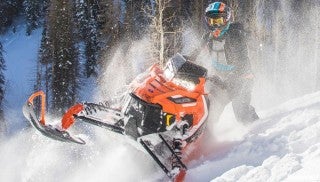
Mountain assaulting is not a crime
First, it is gorgeous. Second, it is nasty looking. Third, it is a full functioning mountain-brawling tough sled that is all AXYS RMK and then some.
In Polaris’ media push, this is what the company states about its newest version RMK Assault: “The Backcountry Original. Tough-As-Nails for Extreme Conditions.”
Polaris’ 2016 AXYS RMK Assault comes to market on the brand new AXYS RMK chassis that allows this RMK to be lighter, stronger and have more lift when it comes to charging out from deep powder holes and when assaulting the nearest mountain side. “Lift” is a keyword from Polaris’ RMK smart folk. Polaris claims the 2016 RMK Assault has more lift than its previous 2015 RMK Assault. “Lift” in Polaris-speak is the AXYS chassis’ ability to launch – move forward – in deep snow with minimal underside drag while maintaining proper weight transfer and staying high atop the snow without compromising handling and control.
Get the Flash Player to see this player. |
You’ll notice right away that the 2016 RMK Assault sits taller at the nose than last year’s Assault. It does it without being tippy. The RMK/SKS engineers lowered the AXYS-chassis RMK’s fuel cell and components near the drivers, while lifting the nose. This gives the AXYS its lift while maintaining a low center-of-gravity (CG) at its center mass. As Polaris states, “The AXYS RMK features a patented, raised chassis that increases clearance and reduces drag to keep you on top of the snow.”
The 2016 RMK Assault is a blend – somewhat – of the AXYS Pro RMK and AXYS SKS with a few ingredients from last year’s 2015 Pro Ride RMK Assault.
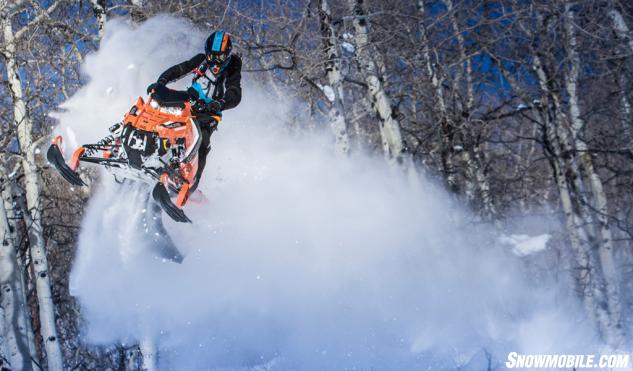 With its new H.O. motor, locked-down AXYS RMK chassis and RMK Coil Over rear suspension, the RMK Assault is a high-flyer with no warts or blemishes.
With its new H.O. motor, locked-down AXYS RMK chassis and RMK Coil Over rear suspension, the RMK Assault is a high-flyer with no warts or blemishes.To understand the RMK Assault is to understand its single purpose: To pound. What do you mean, you ask? To pound moguls, to drop a pound or two on tall drops and long flights, to pound out tracks across the messiest ravines, and to pound on your sled pal when she or he is too weak to follow. It is the hammer of all hammers.
Let’s open up the side panels.
High Output
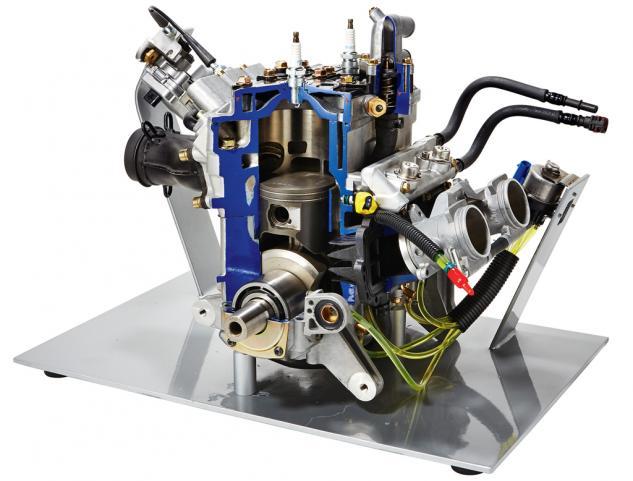 With a horsepower boost and the lighter AXYS chassis the 800 H.O. increases its power-to-weight ratio by 10 percent and enjoys quicker throttle response thanks in part to its three-stage electronically controlled exhaust valves.
With a horsepower boost and the lighter AXYS chassis the 800 H.O. increases its power-to-weight ratio by 10 percent and enjoys quicker throttle response thanks in part to its three-stage electronically controlled exhaust valves.Under the new AXYS RMK Assault’s skin is the new Cleanfire 800 High Output (H.O.) two-stroke twin-cylinder motor. This electronic fuel-injected motor is in its second year from Polaris, used first on the AXYS trail line such as the AXYS Rush and Switchback, and is now used in Polaris’ AXYS mountain line, obviously beginning with this model year.
COMPARISON: Read our review of the 2015 Ski-Doo Freeride 154 + Video
With its increase in horsepower, and the AXYS chassis being lighter than the 2015 RMK Assault, the 800 H.O. increases its power-to-weight ratio by 10 percent; this means, quicker throttle response. The motor has three-stage electronically controlled exhaust valves and an electronic oil pump, which takes drag off the motor. The H.O. has VForce Reed intake valves and a 2.5-pound lighter crankshaft that translates to 25 percent less rotating mass on the crank. The lighter crank translates to faster motor spool up.
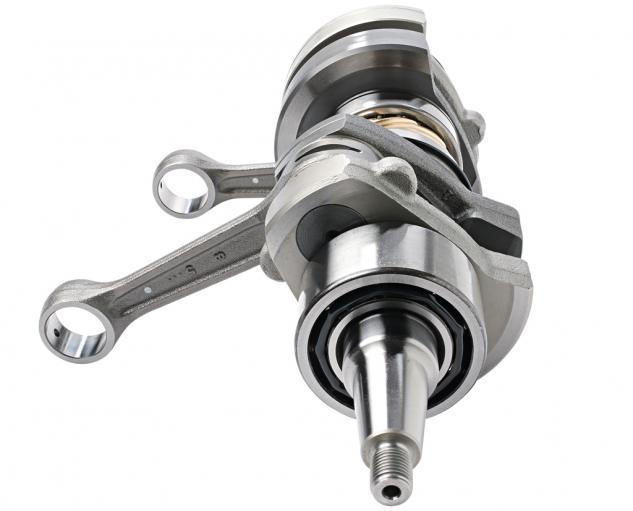 The H.O. has a 2.5-pound lighter crankshaft — that translates to 25 percent less rotating mass on the crank. The lighter crank translates to faster motor spool up.
The H.O. has a 2.5-pound lighter crankshaft — that translates to 25 percent less rotating mass on the crank. The lighter crank translates to faster motor spool up.Track and Trend
Many track options are available for the RMK Assault. First is the single-ply Peak with 2.25-inch tall paddles. Not tall, but suited for marginally deep snow and some hillclimb competitions. Next is the all-new Series-6 2.6-inch paddle track, which Polaris states is the best all-purpose mountain track. For early Snow Check customers, they can choose the new Series-7 that has 3.0-inch paddles. This track is tall and best for crazy deep powder.
The 165-plus horsepower motor has more than enough energy to rotate the short lug 2.25-inch Peak or the new Series-6 2.6-inch powder track – which replaces the Series-5 2.4-inch paddle track. Furthermore, the motor will spin the Series-7 3.0-inch paddle track with ease. This updated motor is not afraid of these three 155-length tracks. Understand, though, that the RMK Assault, like its predecessor, comes only in a 155, nothing shorter or longer.
COMPARISON: Read our review of the 2015 Arctic Cat ProClimb M8000 HCR
The H.O. 800 motor is mated to Polaris’ P-85 drive clutch and a TEAM LWT driven clutch. These are Polaris’ traditional clutches for this model and have proven reliable for mountain action.
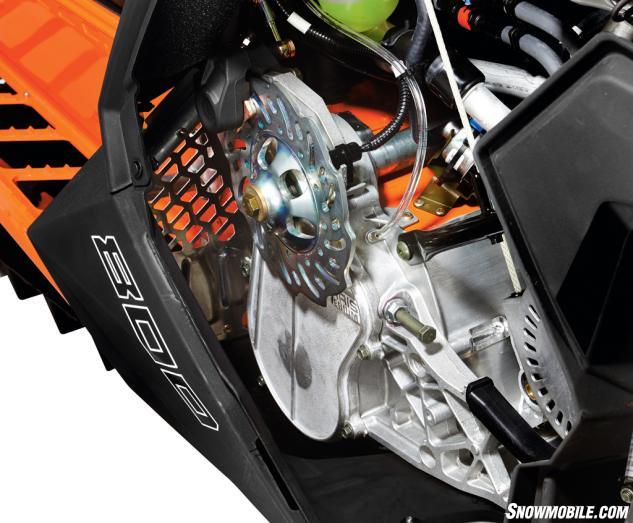 As a tough backcountry runner and per racer input, the Assault uses a chaincase rather than Polaris’ Low-Inertia Quick Drive belt drive system. Professional hillclimbers and big-drop, long-flight boondockers want the ultra-toughness a chaincase delivers.
As a tough backcountry runner and per racer input, the Assault uses a chaincase rather than Polaris’ Low-Inertia Quick Drive belt drive system. Professional hillclimbers and big-drop, long-flight boondockers want the ultra-toughness a chaincase delivers.Absent from the RMK Assault is the Low-Inertia Quick Drive belt drive system. The Assault, per racer input, uses a chaincase. Professional hillclimbers want the ultra-toughness a chaincase delivers. Big-drop and long-flight boondockers that equip their Assault with a turbocharger also demand a chaincase. This is shared tech with the AXYS SKS.
From Front to Rear
The AXYS RMK Assault has the same raised front as the AXYS RMK Pro, but does not rely on the new forged aluminum A-arms. It uses the A-arms from the 2015 RMK Assault. Though slightly heavier than the RMK Pro’s A-arms, racers demand these for their brutal strength.
Ski stance for the RMK Assault is an adjustable 41.5 to 42.5 to 43.5 inches. It uses Walker Evans Needle Shocks and the reliable Gripper ski. The RMK Assault, unlike the Pro RMK does not have a sway bar. With a wider ski stance, the Assault compensates for the width by dropping the sway bar. This, too, is a racer’s demand. We recommend the 41.5-inch ski stance, which is similar to the RMK Pro’s narrowest. Front suspension travel is 10 inches.
Under the tunnel is the light and rigid RMK Coil-Over rear suspension that rides, at the rear track, with Walker Evans Needle shocks. Rear travel is 16 inches. The rigid rear skid is designed and built to control pitch and improve weight transfer. According to Polaris, “the rigid suspension delivers power directly to the snow.”
New for 2016 is a slide/hyfax rail that helps lift the rear skid while driving it forward. The redesigned rails add strength determined via computer-aided design and four years of field testing. The rails are three pounds lighter than last year’s with a 15-percent increase in strength.
Skinny Genes
Polaris believes its RMK’s genes are meant to run through narrow-spaced trees and be smartly balanced on its side when ripping across a hillside.
COMPARISON: Read our review of the 2015 Polaris 800 Switchback Assault 144
Polaris’ RMK/SKS engineers pulled the side panels closer to the motor to minimize paneling out, which is when the side panels prevent the track from locking into a hillside. Given that, the RMK Assault’s side panels are flush with the Powder Trac runningboards and are inside the skis’ outer edge. With the raised platform and narrowed-in side profile, the RMK Assault is dirt bike skinny.
More Goodies
The RMK Assault comes with Polaris’ Powder Trac runningboards, Pro Lite seat, Pro Taper handlebars, and new Interactive Digital Display instrument pod that features GPS mapping and Bluetooth mating.
The ProTaper bar comes with a lower center mountain strap – much appreciated – that is out of the way. Current boondockers do not use the mountain strap much, so minimizing its height is valued. Also, the ProTaper bars are narrower by a half-inch on each side (total one-inch) and come in three different heights. Snow Check buyers can choose their height: low, medium, high.
Assaulting
From the cockpit, the motor’s throttle lever is easy to press and does not fatigue the right hand thumb. The motor breathes well at high-altitudes. In the conditions we rode in – much hardpacked hero snow – the RMK Assault with Series-6 2.6-inch track was delightful. When marginal deep-powder was found in the shadows and in a tree-infested ravine with wicked slopes, the RMK Assault proved a playful critter. But, its mean streak is ever present; it likes to hit. With its Walker Evans shocks and properly set chaincase gear ratio, this sled is mixed martial arts savvy.
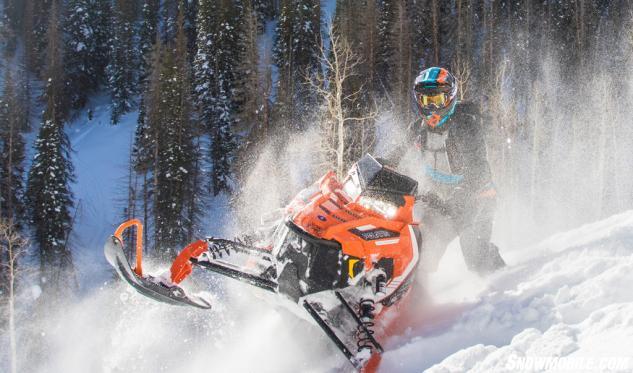 The new design chassis panels flow smoothly into the snow and we liked how the Assault managed its weight transfer and hill ascents.
The new design chassis panels flow smoothly into the snow and we liked how the Assault managed its weight transfer and hill ascents.Here is what we talked about mostly. The RMK Assault set in a 42.5-inch stance (remember, no sway bar on this RMK), and the lowest built ProTaper is crazy fun. Depending on track type, the 155 RMK Assault is 418 pounds to 427 pounds (dry weight), which makes it much, much lighter than its competitor Arctic Cat HCR M8000 153 and Ski-Doo Freeride 154. With its new H.O. motor, locked-down AXYS RMK chassis and RMK Coil Over rear suspension, the RMK Assault has no warts or blemishes.
The chassis did not panel out, as Polaris predicted. We did not have ultra deep-powder to test the lift, but how the RMK Assault managed its weight transfer and hill ascents, we believe it will perform as advertised. One might assume the RMK Assault on hardpack snow, with its lift concept, would tail walk up a hill. Not true. It defies this and maintains a flat presence up a hill. But, owners can manipulate this through rear suspension shock pressure and limiter strap length.
For you Snow Check buyers, choose your color, bar height, windshield color, standard or Interactive instrument pod, graphics, and storage options, and build your dream RMK Assault. For buyers who wait until the Fall harvest is done, and the money (or lack thereof) is counted, then in-season RMK Assaults come mechanically equipped as the spring-buy Snow Check special, minus the optional painted tunnel, bar height choice, optional Series-7 3.0-inch paddle track, storage bags, Interactive Display instrument pod, and various hood colors. Regardless, it is an RMK Assault none-the-less, nasty- and sexy-looking, and all lightweight brawn.
Yes, the RMK Assault is a deep powder player and a monster hill killer. On the trail, it is precise.
| 2016 Polaris 800 AXYS RMK Assault 155 (Series 7 Track)Specs | |
| Engine | Polaris Cleanfire two-stroke high-performance 795cc; bore/stroke of 85mm/70mm; two-cylinder, liquid-cooled; Cleanfire electronic fuel injection system; dry sump lubrication |
| Horsepower | 160+ |
| Drive | Polaris P85 driver and TEAM LWT driven |
| Front Suspension | AXYS Assault adjustable A-arm; Walker Evans Needle shocks; up to 10-in of travel; Gripper skis |
| Rear Suspension | Polaris parallel slide rail RMK Coil-Over; Walker Evans Needle gas shocks; up to 16-inches of travel |
| Length | 131.0 in |
| Height | 49.1 in |
| Width | 46.5 in |
| Ski Stance | Adjustable from 41.5-43.5 in |
| Track | 15 x 155 x 3.0 Series 7 (15x155x2.4 Series 5.1) |
| Weight | 425 (claimed) |
| Brake | Polaris AXYS RMK LWT hydraulic disc brake |
| Features | Optional storage bags, windshields |
| Fuel Capacity | 11.5 US Gal |
| MSRP | US$14,199 – C$15,499 |



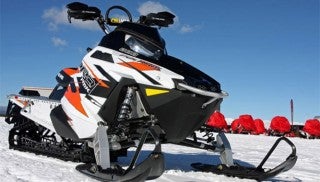




 Your Privacy Choices
Your Privacy Choices